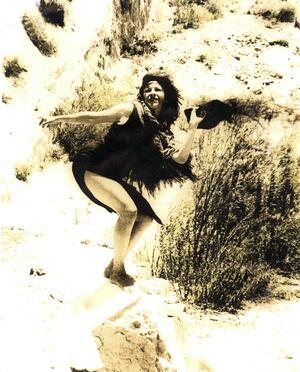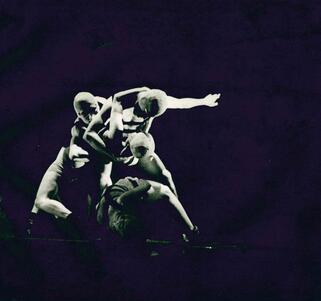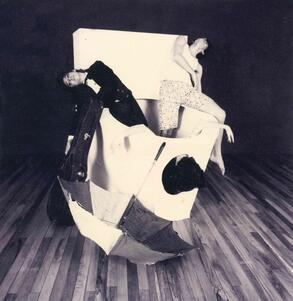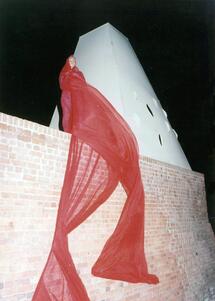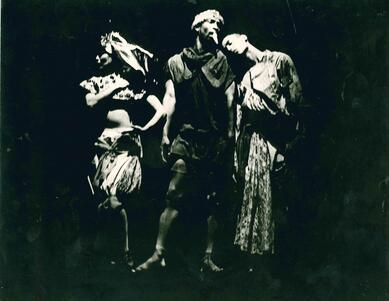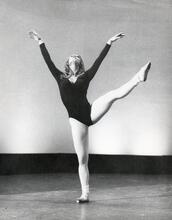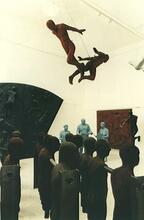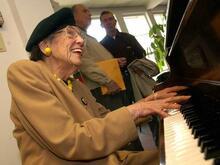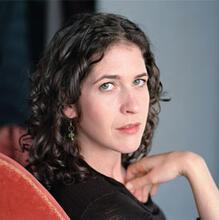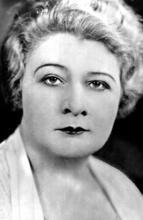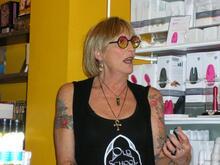Hester Martinez
Born in Mexico City in 1953, Hester Martínez discovered her Jewish ancestry at the age of 20. Because her family wanted her to attend university, only after she got married was she able to pursue a professional career in dance. She has an important career as a dancer, teacher, choreographer, director, promoter, and administrator. She is a graduate of the Higher School of Music and Dance (Escuela Superior de Música y Danza) of the National Institute of Fine Arts (Instituto Nacional de Bellas Artes). She founded her company Contemporary Dance in Concert, created the Percudance technique, and has participated in national and international dance festivals. Since 1997 she has directed the International Festival of Extremadura Dance-Contemporary Language. She is founding director of WIROMA Circle Dances and is an influential artist in Nuevo León and across Mexico.
Family and Early Education
Hester Rose Martínez Nardea was born in Mexico City on July 29, 1953. At the age of 20, she discovered she had Jewish ancestry: her mother explained that the family had decided to keep it a secret in order to avoid the anti-Semitism they had experienced. Hester’s maternal grandparents had fled from Turkey and settled in Cuba, where Hester’s mother, Susana Nardea, was born. Susana and her family experienced discrimination and insults in Cuba because of their Jewish origin. In Cuba, Susana met and married José Martínez, a Guatemalan national. Susana was a practicing Jew until she got married. Susana and José moved to New York, then back to Cuba, after which they traveled to many countries with Hester and her three siblings. Growing up, the four children did not know their mother was a Sephardi Jew. Hester has not experienced anti-Semitism in Mexico because no one is aware of her Sephardic ancestry. Indeed, this is the first time she has spoken of the subject.
Because Martínez’s father was a diplomat, the family lived in Cuba, Canada, Venezuela, Panama, and the United States; in 1964 they settled in Monterrey, Nuevo León, in the northern part of Mexico. (Coincidentally, that state had been founded by a Jew, Luis de Carvajal y de la Cueva—a Portuguese slave owner and New Christian—as the New Kingdom of Leon in 1567; he established a separate Jewish colony with Conversos and Crypto-Jews, but the Carvajal family was later persecuted for judaizing.)
When Hester found out about her Jewish origin, it came as a big surprise and she felt confused. She now understands the rejection of some of her relatives, who considered that Susana and her children had denied their origins, which was not true of the children, given that they didn’t even know what these were. Hester also understands that her mother hid her Judaism in order to be accepted, because at the time, Monterrey was a very closed and Catholic community. Hester honored her mother’s wish never to discuss the subject. In her later years, when she was living in the United States, her mother resumed Judaism openly. Today in Nuevo León, some families are claiming their Sephardi roots and society has become more accepting. Hester has been reunited with her maternal family and, although she never experienced anti-Semitism, one of her sisters did, both in Mexico and Spain. Hester has been subjected to discrimination in the United States for being Mexican.
In Monterrey, Hester Martinez graduated from the Monterrey Technological Institute of Higher Studies (Instituto Tecnológico de Estudios Superiores de Monterrey) as an architect and tried to become involved in dance, but her parents objected that it was an unworthy career with a low income.
Becoming a Professional Dancer
In1976 Hester Martínez married Jesús José Herrera Giammattei; in 1977she began studying Martha Graham modern dance technique and ballet at the Autonomous University of Nuevo Leon (Universidad Autónoma de Nuevo León) and became a dance teacher. Martínez and her husband traveled to England so that both could study for master’s degrees in architecture. While in England, she took dance classes at Newcastle Upon Tyne University with teachers from the London Contemporary Dance Theatre, such as Ross McKim and Sue Little (former dancers with the Martha Graham Dance Company).
When Martínez returned to Monterrey, she decided to dedicate herself to dance professionally. In 1979, she joined the newly created Higher School of Music and Dance (Escuela Superior de Música y Danza) of the National Institute of Fine Arts (Instituto Nacional de Bellas Artes INBA). She studied simultaneously to become a contemporary dance performer and a classical dance teacher. Anthropos (Anthropos), the first piece she choreographed, together with Alejandra Serret, won second place in the1981National Dance Award competition in Mexico City.
In 1981, Martínez was appointed coordinator of Contemporary Dance at the Higher School of Music and Dance. She restructured the department and founded the Choreography Workshop, where she applied her knowledge as an architect to create many dances with her students, some of whom are now well-known dance artists. She received a scholarship to study at the Superior Choreographic Center (Centro Superior de Coreografía) in Mexico City and promoted an exchange program with teachers of the Graham and Francis techniques.
Danza Contemporánea en Concierto
When her first daughter was born in 1984, Martínez resigned as coordinator, but she continued as teacher at the Higher School of Music and Dance. The following year she formed her own group, Contemporary Dance in Concert (Danza Contemporánea en Concierto), at a time when independent groups were being formed in Monterrey and across the nation, and the power relations in the dance field was changing. With additional impetus from the dance schools at the Autonomous University of Nuevo Leon and the Higher School of Music and Dance, the new groups turned Monterrey into one of the most important official as well as independent centers of dance in Mexico. Martínez’s influence with her group and her work as a teacher were central to this process and inspired many young people to become dancers and choreographers.
Contemporary Dance in Concert participated in the Metropolitan Contemporary Dance Encounter of Monterrey (Encuentro Metropolitano de Danza de Monterrey), founded in 1986. It also took part in other national projects, such as the Street Encounter of Contemporary Dance (Encuentro Callejero de Danza Contemporánea), which was held in Mexico City in 1987 and was an artistic response to the 1985 earthquake.
Martínez Nardea premiered numerous works with Contemporary Dance in Concert: An Absurd Reality (Una realidadabsurda, 1986), a piece that criticizes social differences; …%&????...!!!!!... (1989), which mocks the need to "understand" contemporary art; and Ode to Mexico (Oda a Mexico, 1989), a dance about Mexican customs relating to death and home. This last piece was included in the Dance Collection of the Lincoln Center Library of New York in 1991.
In 1989, Martínez Nardea’s second daughter was born and, together with her sister, the girls accompanied their mother to classes, rehearsals, and performances, an experience common to many dance mothers enabling them to juggle professional and family life.
Contemporary Dance in Concert traveled several times to the United States and Canada to perform at The Guadalupe Theater in San Antonio, Texas, in 1987; The Fringe Festival of Canada (the company was considered one of "Edmonton’s Fringe best bets 1990"), where Graham Hicks wrote that Hester’s work "was as tasty as water after a desert sojourn. Finally, a modern dance company that puts more of a premium on the movement rather than the message. The choreography was clearly articulated and balanced". (Hicks, 1990)
Martínez also performed at the Carver Community Cultural Center in San Antonio in 1992. In 1994 she presented Wiroma (Offering) at The Fringe Festival, where it was rated "one of the five best shows at Edmonton’s Fringe 1994" (Tortajada 2015). The following year she returned to The Fringe Festival with Movus, which The Edmonton Sun considered "challenging, ethereal, sensual, spooky and just downright weird. Movus is a statement of the industrial society’s intent to take the ‘human’ out of the ‘human beings’" (Lackey, 1995). In 1996 she presented Ode to Mexico (Oda a Mexico) at the Out-of-Doors Lincoln Center Festival in New York.
Martínez Nardea received a Ford Foundation grant to work at The Guadalupe Cultural Arts Center for the Gateways 96 Program and created From Jarocha to Pocha (De jarocha a pocha), which premiered in San Antonio in 1996.
A reflection on dance and technique
Martínez Nardeacreated Entropy (Chaos) (Entropía (Caos)) in 1997 after reading Hermes Trimegisto’s book The Kybalion, which made herreflect on religion and her Jewish origin: "I convinced myself that all beliefs are both true and false. I firmly believe that the truth is in each one of us, according to the life we live. I consider myself a spiritual person, but not a religious one. I don’t go to any church, but I have visited many in search of the truth: Catholic, Protestant, the synagogue, the Buddhist temple; I spent time with the Krishnas, I walked through the mountains with raramuris, huicholes, and kikapu looking for the truth after so much confusion about my origin" (Martínez 2020).
Entropy evolved into a new technique, the Percudance technique. Martínez developed this technique, which includes elements of ballet, afro, folk, and contemporary dance, over ten years from 1997 to 2007, with workshops and choreography. She has presented it in forums in Mexico, the Percuba Festival in Cuba (1999), the Darprana Academy of Performing Arts in Ahmedabad, India (2000), and the Miller Outdoor Theatre in Houston (2005).
Martínez also created shows of urban dances and dances for children, and in 2002 she headed the interdisciplinary staging of So you shall be (Asíteverás) at the Parque Fundidora in Monterrey. In 2008, her work was recognized by Dance Magazine, which described her as a choreographer with a "gift" for experimentation (Tortajada 2015).
Projects and Recognition
Hester Martínez Nardea receiving a Tribute to a Life in Dance (Homenaje Una vida en la danza) from Mexico’s National Institute of Fine Arts (Instituto Nacional de Bellas Artes), 2015.
Martínez has taught dance, dance theory, composition, and management in Mexico, Canada, Cuba, the United States, India, Peru, and Ireland. She has extensive experience organizing and curating performing arts, having promoted numerous festivals and gatherings in Mexico and the United States. In 1997 she founded the International Festival of Extremadura Dance-Contemporary Language (Festival Internacional de Danza Extremadura-Lenguaje Contemporáneo), which has been a platform for groups from Mexico, United States, Spain, Japan, Sweden, Finland, Germany, France, Chile, Argentina, China, Canada, Ecuador, Brazil, Costa Rica, and Italy.
From 2012 to2016, Martínez was director of the Center for Artistic Education "Alfonso Reyes" of the INBA, where she improved the academic and artistic levels and established networks with other educational institutions.
Martínez has received numerous awards from educational and cultural institutions in Nuevo León, Tamaulipas, Mexico City, San Luis Potosí, and Coahuila. In 2015 she was awarded the Tribute to a Life in Dance (Homenaje Una vidaen la danza) by the INBA. The following year the Creator Emeritus category was bestowed on her by CONARTE (Consejo para la Cultura y las Artes de Nuevo León), and she has been recipient of many scholarships and grants for choreography. She has published articles in various media and in 2016 co-authored the book Communicating Vessels: Two festivals in the North with Luis Javier Alvarado
Martínez completed diploma courses in cultural management, leadership, and administration. She plays a central role in the organization of artists in Nuevo León and the National Network of Dance Festivals of the INBA, to which the Extremadura Festival belongs.
Since her retirement from the INBA in 2016, Martínez has promoted the Dance Center in Monterrey as well as the group "Humanism, Arts and Fourth Revolution”, which advocates for the promotion of and reflection on the performing arts and their connection to science. In 2018 she founded the group WIROMA Circle Dances, which fosters dance as an inclusive practice for the enjoyment of movement in a community setting. She has organized workshops with teachers such as Gwyn Peterdi, Andrés Rey, Collette De Porre, Claudio Delfini, Bruno Perel, Cinthyia Valenzuela, and Beleni Kumara, among others.
Charles, John. “Graceful Offerings.” The Edmonton Sun, August 17, 1994.
Hicks, Graham. “Fringe Dance Shows pick up. Gettin’ hot!” The Edmonton Sun. August 23, 1990.
Lackey. “Not for the bingo crowd.” The Edmonton Sun, August 20, 1995.
Martínez, Hester. Personal communication with the author, March 10, 13 and 30, 2020.
Martínez, Hester. “The Dance in Culture” (“La danza en la cultura”). De puerta en puerta n. 50 (September 29-October 5, 1997): 20.
Martínez, Hester. “Prismatic Reflections” (“Reflexiones prismáticas”). Homo Ludens n. n. 1 (July-December 2010): 50.
Martínez Nardea, Hester and Luis Javier Alvarado Ramírez. Communicating Vessels. Two Northern Festivals. (Vasoscomunicantes. Dos festivales en el norte). Saltillo: Asociación Cultural Rodas AC-Secretaría de Cultura-INBA, 2016.
Tortajada Quiroz, Margarita. “Hester Martínez: Dancing with Rigour and Audacity” (“Hester Martínez, danza con rigor y audacia”). Tribute to a Life in Dance (Homenaje Una vida en la danza 2015). México: Cenidi Danza-INBA, 2015: 46-67.

